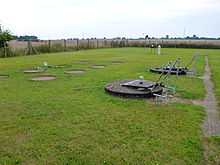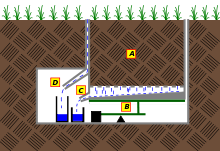Lysimeter

A lysimeter is a measuring device which can be used to measure the amount of actual evapotranspiration which is released by plants, usually crops or trees. By recording the amount of precipitation that an area receives and the amount lost through the soil, the amount of water lost to evapotranspiration can be calculated.[1] Lysimeters are of two types: Weighing and non-weighing.
Use

A lysimeter is most accurate when vegetation is grown in a large soil tank which allows the rainfall input and water lost through the soil to be easily calculated. The amount of water lost by evapotranspiration can be worked out by calculating the difference between the weight before and after the precipitation input.
For trees, lysimeters can be expensive and are a poor representation of conditions outside of a laboratory as it would be impossible to use a lysimeter to calculate the water balance for a whole forest. But for farm crops, it can represent field conditions well since it is done outside the laboratory. A weighing lysimeter, for example, reveals the amount of water crops use by constantly weighing a huge block of soil in a field to detect losses of soil moisture.[2]

The University of Arizona's Biosphere 2 built the world's largest weighing lysimeters using a mixture of thirty 220,000 and 333,000 lb-capacity column load cells from Honeywell, Inc. as part of its Landscape Evolution Observatory project.[3]
History
In 1875 Edward Lewis Sturtevant, a botanist from Massachusetts, built the first lysimeter in the United States.[4]
References
- ↑ Tim Davie, Fundamentals of hydrology (Routledge, 2003) pg. 35 http://books.google.com/books?id=XAGt03ANojgC&source=gbs_navlinks_s
- ↑ Rana, G. and N. Katerji. 2000. Measurement and estimation of actual evapotranspiration in the field under Mediterranean climate: a review. European Journal of Agronomy 13:125-153.
- ↑ leo.b2science.org
- ↑ Sturtevant E. Lewis (Edward Lewis), Sturtevant's Notes on Edible Plants (BiblioBazaar, LLC, 2009), pg. 4 http://books.google.com/books?id=Rbbe0Xx0DuoC&source=gbs_navlinks_s
]